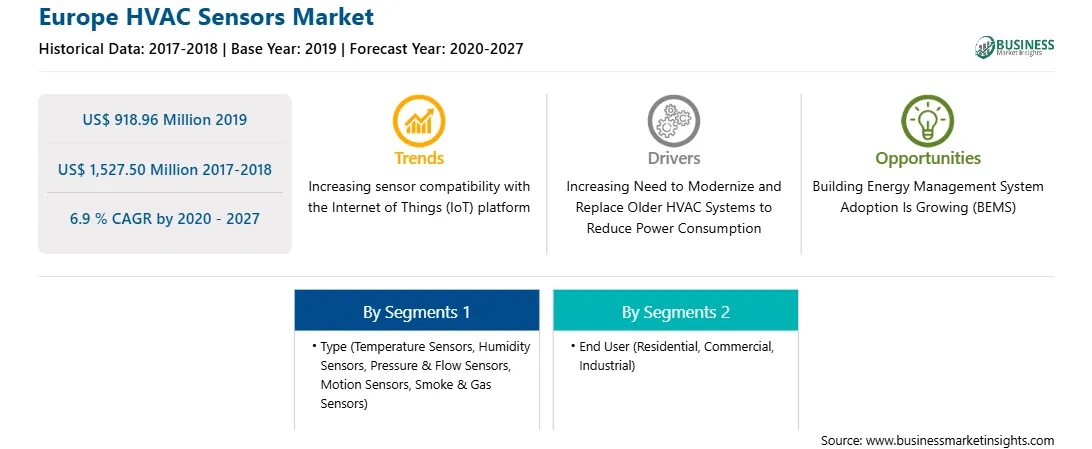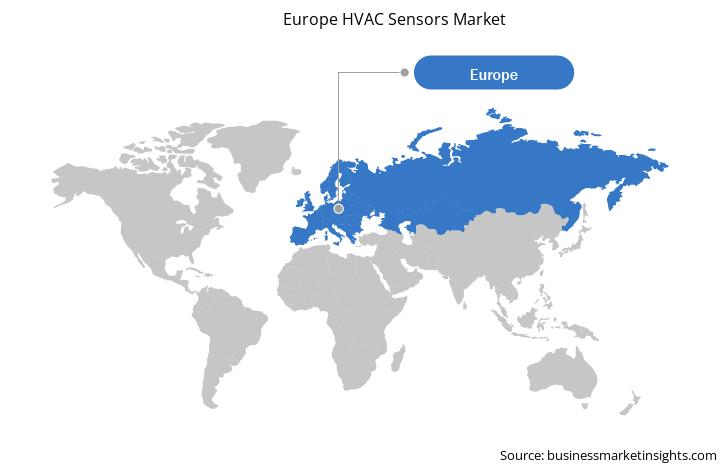欧洲 HVAC 传感器市场预测至 2027 年 - COVID-19 影响和区域分析(按类型(温度传感器、湿度传感器、压力和流量传感器、运动传感器、烟雾和气体传感器等)和最终用户(住宅、商业和工业) )
No. of Pages: 147 | Report Code: TIPRE00020051 | Category: Electronics and Semiconductor
No. of Pages: 147 | Report Code: TIPRE00020051 | Category: Electronics and Semiconductor
暖通空调系统在商业建筑、住宅和汽车行业中的广泛采用正在推动欧洲暖通空调系统的增长传感器市场。日益严格的污染标准和对能源消耗的日益关注推动了暖通空调系统采用先进传感器。此外,公司正在开发先进的 HVAC 传感器,以提高 HVAC 系统的效率。例如,2020 年 3 月,瑞士公司 BELIMO 推出了适用于 HVAC 应用的新型超声波流量传感器。这些嵌入式流量传感器配备自动乙二醇测量和补偿功能,可最大限度地提高 HVAC 系统效率。为了提高系统效率而不断开发的传感器正在推动工业、商业和住宅领域市场的增长。在欧洲,政府对高效建筑管理系统的严格法规推动了对 HVAC 传感器的需求。此外,欧洲强大的汽车制造单位的存在正在推动对汽车中使用的 HVAC 传感器的需求。欧洲地区各国政府正在重点关注旅游业的发展和工业部门的增长,预计这将增加该地区对暖通空调系统的需求。
此外, 如果出现 COVID-19,欧洲将受到严重影响,特别是英国。欧洲暖通空调传感器制造商的欧洲和国际暖通空调系统制造商的需求率较低。欧洲半导体制造商已经观察到并且也经历了向各自客户提供足够数量的产品的艰难时期。这主要是由于原材料供应链业务的严重中断。半导体元件或传感器制造商的原材料接收延迟了两周或更长时间,这迫使制造商放慢生产速度,这显示出收入下降的趋势。英国和法国拥有众多的HVAC系统和HVAC传感器制造商,而俄罗斯拥有大量的HVAC设备制造商。 COVID-19 病毒的出现对欧洲 HVAC 系统制造商以及 HVAC 传感器市场参与者的业务产生了负面影响。此外,英国、法国、德国和意大利在过去几周一直在观察第二波 COVID-19,这再次迫使制造商限制其生产部门的劳动力,导致 HVAC 传感器需求减速。< /p>
欧洲 HVAC 传感器市场预计将从 2019 年的 9.1896 亿美元增长到 2.5 亿美元到2027年将达到15.275亿;预计 2020 年至 2027 年复合年增长率为 6.9%。欧洲地区智慧城市的增长预计将推动欧洲 HVAC 传感器市场的发展。由于欧洲发展中国家的智慧城市仍处于发展阶段,各国政府都在各自经济体中积极推动智慧城市的发展。欧洲政府对绿色、智慧城市的倡议,为当前欧洲暖通空调行业发展节能、经济的暖通空调系统增添了动力。这导致暖通空调市场参与者的重点转向欧洲市场。此外,欧盟委员会 (EC) 在其智慧城市倡议下旨在大力推广节能和低碳技术。欧洲各国政府对智能城市发展的日益关注预计将进一步创造对 HVAC 传感器的需求,这将在预测期内推动欧洲 HVAC 传感器市场。
从类型来看,温度传感器细分市场在2019年欧洲HVAC传感器市场中占据最大份额。从最终用户来看,商业细分市场占据了最大份额。 2019 年欧洲 HVAC 传感器市场份额更大。
准备本欧洲 HVAC 传感器市场报告时提到的一些主要一手和二手来源包括公司网站、年度报告、财务报告、国家政府文件和统计数据库等。报告中列出的主要公司有BELIMO AIRCONTROLS (USA), INC.;艾默生电气公司;霍尼韦尔国际公司;江森自控公司;施耐德电气;森马蒂克公司;森萨塔科技公司;盛思锐股份公司;西门子公司; TE Connectivity Ltd.
Strategic insights for Europe HVAC Sensors involve closely monitoring industry trends, consumer behaviours, and competitor actions to identify opportunities for growth. By leveraging data analytics, businesses can anticipate market shifts and make informed decisions that align with evolving customer needs. Understanding these dynamics helps companies adjust their strategies proactively, enhance customer engagement, and strengthen their competitive edge. Building strong relationships with stakeholders and staying agile in response to changes ensures long-term success in any market.

| Report Attribute | Details |
|---|---|
| Market size in 2019 | US$ 918.96 Million |
| Market Size by 2027 | US$ 1,527.50 Million |
| Global CAGR (2020 - 2027) | 6.9 % |
| Historical Data | 2017-2018 |
| Forecast period | 2020-2027 |
| Segments Covered |
By 类型
|
| Regions and Countries Covered | 欧洲
|
| Market leaders and key company profiles |
The regional scope of Europe HVAC Sensors refers to the geographical area in which a business operates and competes. Understanding regional nuances, such as local consumer preferences, economic conditions, and regulatory environments, is crucial for tailoring strategies to specific markets. Businesses can expand their reach by identifying underserved regions or adapting their offerings to meet regional demands. A clear regional focus allows for more effective resource allocation, targeted marketing, and better positioning against local competitors, ultimately driving growth in those specific areas.

The Europe HVAC Sensors Market is valued at US$ 918.96 Million in 2019, it is projected to reach US$ 1,527.50 Million by 2027.
As per our report Europe HVAC Sensors Market, the market size is valued at US$ 918.96 Million in 2019, projecting it to reach US$ 1,527.50 Million by 2027. This translates to a CAGR of approximately 6.9 % during the forecast period.
The Europe HVAC Sensors Market report typically cover these key segments-
The historic period, base year, and forecast period can vary slightly depending on the specific market research report. However, for the Europe HVAC Sensors Market report:
The Europe HVAC Sensors Market is populated by several key players, each contributing to its growth and innovation. Some of the major players include:
The Europe HVAC Sensors Market report is valuable for diverse stakeholders, including:
Essentially, anyone involved in or considering involvement in the Europe HVAC Sensors Market value chain can benefit from the information contained in a comprehensive market report.